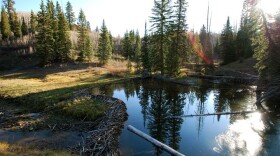It could be an overly nuanced distinction to folks who don’t live in the mountains and spend much time in the woods, but I’ll make the case anyway: winter camping and hut trips are two very different experiences. One requires a tolerance for cold and a degree of suffering most people would prefer to pass up; the other involves cozy accommodations, light packs and comfy mattresses. Both usually include spectacular winter scenery and close friends.

Having just come back from both a hut trip and winter camping trip, I’ve been reflecting on the differences, and they’re more than just temperature-related. (And in full disclosure, the winter camping trip wasn’t as cold has it might have been thanks to a small portable wood stove inside our nylon tepee – a.k.a. the “fire tent.”)
More than temperature and creature comforts, it was the degree of wildness and solitude that set the two trips apart. Our camping trip was only a few miles up a trail off Castle Creek Road, but after only a few minutes of skinning we crossed into the Maroon-Bells Snowmass Wilderness, and by the time we reached our camp a couple hours later, a deep feeling of remoteness and seclusion had set in. We collected firewood for warmth and listened to coyotes bark and yip in the evening’s first dark. Arcing powder turns down the slope above our tent the next day, we were sure we had the entire place to ourselves.
The hut trip brought us to both the Markley and Opa’s Taylor huts, (major kudos to the Braun Huts folks on the latter, which opened last winter). Over the course of the trip we traveled on snow-covered roads, saw dozens of old tracks left by previous groups, heard the faint sound of snowmobiles touring along Richmond Ridge, and ran into a couple other groups of fellow skiers making their way to and from huts. These are small events in the context of great skiing, wonderful views into wilderness areas and conversations with old friends, and yet large enough to differentiate one trip from the other. Wildness was available when we wanted it, but inside the huts we could retreat into board games, magazines and oven-baked brownies. These welcome amenities made the trip a vacation as much as an adventure.
Don’t get me wrong, I’m not about to stop going on hut trips (in fact I’ve got five more lined up for this winter), but like many other folks I can get lulled into the ease of the wonderful amenities, and forget the wildness and adventure that awaits beyond. Maybe it’s time to get a little cold again this winter.

Will Roush has worked at the Wilderness Workshop since the summer of 2009 where he began by inventorying lands proposed for wilderness designation. Now that those lands are part of congressional wilderness proposals he works as an organizer and advocate to designate those lands and to protect the Thompson Divide from gas development. Will also organizes the Naturalist Nights winter speaker series, runs Wilderness Workshop's restoration program, and serves on the steering committee of the Roaring Fork Valley Future Forest Roundtable. Will grew up in the Roaring Fork Valley and has a masters in Geography and Environmental Studies examining the impact of climate change on alpine ecosystems. He currentlyserveson the boards of ACES and Ecojustice, Canada's only national environmental law firm. When not at a desk, Will likes to play in the woods, on the rocks and over the snow.





